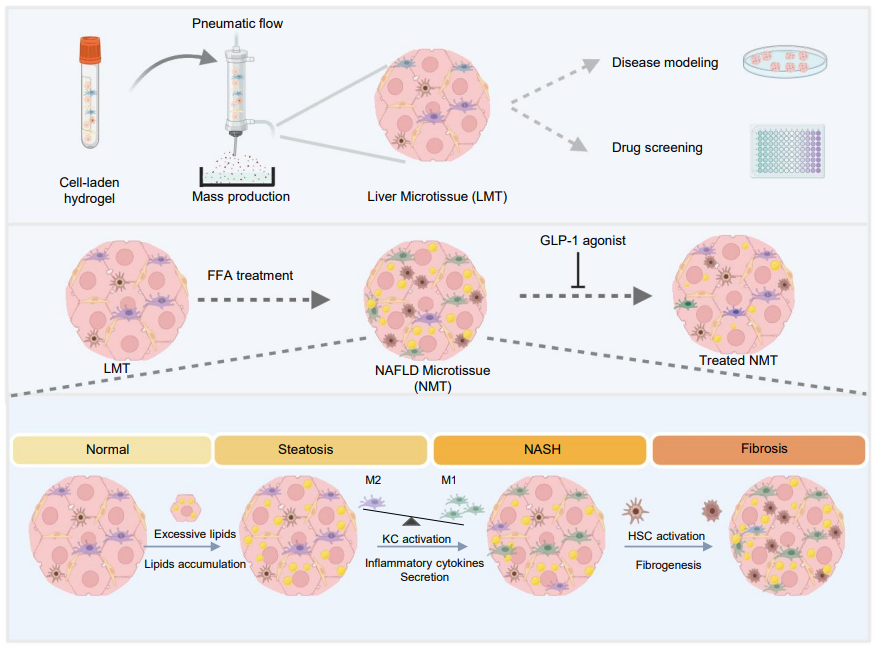Bioengineering scalable and drug-responsive in vitro human multicellular non-alcoholic fatty liver disease microtissues encapsulated in the liver extracellular matrix-derived hydrogel
DOI:
https://doi.org/10.17179/excli2023-6878Keywords:
non-alcoholic fatty liver disease, metabolic dysfunction-associated fatty liver disease, liver microtissue, bioengineering, drug screening, liraglutideAbstract
Non-alcoholic fatty liver disease (NAFLD) is a high-prevalence and progressive disorder. Due to lack of reliable in vitro models to recapitulate the consecutive phases, the exact pathogenesis mechanism of this disease and approved therapeutic medications have not been revealed yet. It has been proven that the interplay between multiple hepatic cell types and liver extracellular matrix (ECM) are critical in NAFLD initiation and progression. Herein, a liver microtissue (LMT) consisting of Huh-7, THP-1, and LX-2 cell lines and human umbilical vein endothelial cells (HUVEC), which could be substituted for the main hepatic cells (hepatocyte, Kupffer, stellate, and sinusoidal endothelium, respectively), encapsulated in liver derived ECM-Alginate composite, was bioengineered. When the microtissues were treated with free fatty acids (FFAs) including Oleic acid (6.6×10−4M) and Palmitic acid (3.3×10−4M), they displayed the key features of NAFLD, including similar pattern of transcripts for genes involved in lipid metabolism, inflammation, insulin-resistance, and fibrosis, as well as pro-inflammatory and pro-fibrotic cytokines’ secretions and intracellular lipid accumulation. Continuing FFAs supplementation, we demonstrated that the NAFLD phenomenon was established on day 3 and progressed to the initial fibrosis stage by day 8. Furthermore, this model was stable until day 12 post FFAs withdrawal on day 3. Moreover, administration of an anti-steatotic drug candidate, Liraglutide (15 μM), on the NAFLD microtissues significantly ameliorated the NAFLD phenomenon. Overall, we bioengineered a drug-responsive, cost-benefit liver microtissues which can simulate the initiation and progression of NAFLD. It is expected that this platform could potentially be used for studying molecular pathogenesis of NAFLD and high-throughput drug screening.

Downloads
Additional Files
Published
How to Cite
License
Copyright (c) 2024 Negar Asadollahi, Mohammad Amin Hajari, Mahmoud Alipour Choshali, Mohammad Ajoudanian, Seyed Ali Ziai, Massoud Vosough, Abbas Piryaei

This work is licensed under a Creative Commons Attribution 4.0 International License.
Authors who publish in this journal agree to the following terms:
- The authors keep the copyright and grant the journal the right of first publication under the terms of the Creative Commons Attribution license, CC BY 4.0. This licencse permits unrestricted use, distribution and reproduction in any medium, provided that the original work is properly cited.
- The use of general descriptive names, trade names, trademarks, and so forth in this publication, even if not specifically identified, does not imply that these names are not protected by the relevant laws and regulations.
- Because the advice and information in this journal are believed to be true and accurate at the time of publication, neither the authors, the editors, nor the publisher accept any legal responsibility for any errors or omissions presented in the publication. The publisher makes no guarantee, express or implied, with respect to the material contained herein.
- The authors can enter into additional contracts for the non-exclusive distribution of the journal's published version by citing the initial publication in this journal (e.g. publishing in an institutional repository or in a book).





